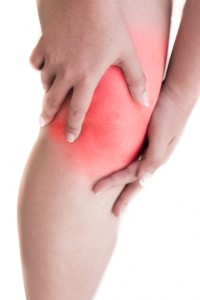Patellar tendinopathy (or tendonitis) is a painful condition that affects the patellar tendon across the knee. Because of the great stress that is placed on the patellar tendon during jumping sports, it is often referred to as Jumper’s Knee.
What is patellar tendinopathy?
Patellar tendinopathy describes damage to and subsequent inflammation of the patellar tendon. This is the tendon that runs across the front of the knee and attaches the quadriceps and the patella (kneecap) to the tibia (shin bone). It works to both help straighten the knee from a bent position, as well as to protect the knee joint by helping keep the patella in place. The patella tendon (and quadriceps from where it originates) play an essential role in our ability to run, kick, jump, and generally move our legs.
What causes damage to the patellar tendon?
 Patellar tendinopathy is typically an overuse injury in high-impact sports, occurring when the tendon is repeatedly stressed and overloaded. This results in small tears through the tendon fibres and the onset of symptoms. An example of such overloading is repetitive jumping (and landing) like in volleyball or netball, as well as sports where players start and stop quickly, and often change direction. Additional causes include:
Patellar tendinopathy is typically an overuse injury in high-impact sports, occurring when the tendon is repeatedly stressed and overloaded. This results in small tears through the tendon fibres and the onset of symptoms. An example of such overloading is repetitive jumping (and landing) like in volleyball or netball, as well as sports where players start and stop quickly, and often change direction. Additional causes include:
- Poor training technique
- Increased impact on hard surfaces
- Poor foot biomechanics
- Sudden increases in training intensity without adequate preparation
- Muscular imbalances (e.g. tight hamstrings or weak quads)
Without adequate management and recovery, the damage to the patellar tendon may result in long-term weakness with ongoing issues. This is the case for most of the older population that develop patellar tendinopathy, where damage to the patellar tendon has accumulated over time.
What are the symptoms?
Symptoms of patellar tendinopathy can include:
- Knee pain around the anterior knee and particularly below the kneecap
- Gradual onset of pain
- Swelling
- Stiffness
- Tenderness and aching, especially following activity
- Pain on walking and activities that extend the knees, such as squatting
Why it’s important to effectively treat patellar tendinopathy
If you have knee pain and suspect you may have patellar tendinopathy, you’ll want to take care and ensure to get it checked by your podiatrist. While it may start out as an uncomfortable niggle, it can weaken significantly and become a longstanding (chronic) tendinopathy with a very long recovery time to get the tendon back to its full strength and function.
Proper care and management at the early stages stops this progression and helps restore your tendon to its healthy, fully functioning state in a much faster time and with much less effort.
How is treated?
 Until you’re able to have an assessment with your podiatrist, start by stopping the activity that first caused the pain and any activity that directly triggers the pain. Attempting to move through the pain can cause further damage to the tendon, which may lead to a tear in the tendon. Applying the PRICE principles (protection, rest, ice, compression and elevation) can help reduce the initial pain and swelling where present.
Until you’re able to have an assessment with your podiatrist, start by stopping the activity that first caused the pain and any activity that directly triggers the pain. Attempting to move through the pain can cause further damage to the tendon, which may lead to a tear in the tendon. Applying the PRICE principles (protection, rest, ice, compression and elevation) can help reduce the initial pain and swelling where present.
Your Podiatrist will conduct a thorough biomechanical examination and develop a personalised management plan to get you recovered and ready to play as quickly and effectively as possible. This may include:
- Strengthening muscles surrounding the knees such as the quadriceps, hamstrings, calves, buttocks and pelvic muscles
- Stretching when appropriate to address tight muscles
- Using custom-designed orthotics to help correct biomechanical abnormalities and support good alignment and functioning of the legs and knees
- Assessing the stability and support of your footwear
- Assessing your walking/running technique
 Patellar tendinopathy is typically an overuse injury in high-impact sports, occurring when the tendon is repeatedly stressed and overloaded. This results in small tears through the tendon fibres and the onset of symptoms. An example of such overloading is repetitive jumping (and landing) like in volleyball or netball, as well as sports where players start and stop quickly, and often change direction. Additional causes include:
Patellar tendinopathy is typically an overuse injury in high-impact sports, occurring when the tendon is repeatedly stressed and overloaded. This results in small tears through the tendon fibres and the onset of symptoms. An example of such overloading is repetitive jumping (and landing) like in volleyball or netball, as well as sports where players start and stop quickly, and often change direction. Additional causes include:
 Until you’re able to have an assessment with your podiatrist, start by stopping the activity that first caused the pain and any activity that directly triggers the pain. Attempting to move through the pain can cause further damage to the tendon, which may lead to a tear in the tendon. Applying the PRICE principles (protection, rest, ice, compression and elevation) can help reduce the initial pain and swelling where present.
Your Podiatrist will conduct a thorough biomechanical examination and develop a personalised management plan to get you recovered and ready to play as quickly and effectively as possible. This may include:
Until you’re able to have an assessment with your podiatrist, start by stopping the activity that first caused the pain and any activity that directly triggers the pain. Attempting to move through the pain can cause further damage to the tendon, which may lead to a tear in the tendon. Applying the PRICE principles (protection, rest, ice, compression and elevation) can help reduce the initial pain and swelling where present.
Your Podiatrist will conduct a thorough biomechanical examination and develop a personalised management plan to get you recovered and ready to play as quickly and effectively as possible. This may include:








